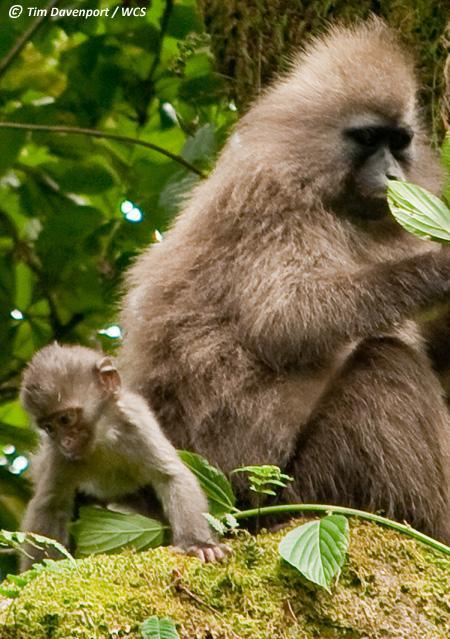Rare Baby African Monkey Makes Photo Debut

A baby kipunji, one of the rarest species of African monkey, sticks close to its mother in a new photo that was released today (June 5) by wildlife conservationists.
The Wildlife Conservation Society (WCS), headquartered in New York City, circulated the photo of the baby kipunji (Rungwecebus kipunji) this morning on Twitter.
Kipunji, also known as the highland mangabey, are considered a critically endangered species by the International Union for Conservation of Nature. A WCS census of the monkey species has revealed that only 1,100 are known to exist in the wild.
The tree-dwelling kipunji was first discovered in 2003. In 2006, genetic analyses revealed it to be an entirely new primate genus — the first new African monkey species since 1984.
Kipunji are found in Tanzania, and two years after they were discovered, the WCS helped create a protected forest on Mount Rungwe to promote the conservation of these rare primates. The sanctuary also enabled WCS researchers to study kipunji up close in their natural habitat.
"In this forest, we have had a habituated group of kipunji that we have followed every day for over four years," Tim Davenport, director of WCS's Tanzania Program, told LiveScience in an email.
The baby kipunji's mother is one of the monkeys being studied by the WCS. This dominant female, nicknamed Trike, is believed to have lost a hand and lower arm in a snare accident before the creation of the protected forest in the southern highlands of Tanzania.
Get the world’s most fascinating discoveries delivered straight to your inbox.
"Before we managed the forest, there was illegal hunting going on, including snaring," WCS spokesman Stephen Sautner told LiveScience.
Yet, even with only three full limbs, the female kipunji is thriving and is able to successfully care for her baby, who is just a few weeks old, Davenport said.
Kipunji have two main characteristics that help distinguish it from other monkey species: A wide crest of hair on the tip of its head, and a unique call that has been described by researchers as a "honk-bark."
Follow Denise Chow on Twitter @denisechow. Follow LiveScience @livescience, Facebook & Google+. Original article on LiveScience.com.

Denise Chow was the assistant managing editor at Live Science before moving to NBC News as a science reporter, where she focuses on general science and climate change. Before joining the Live Science team in 2013, she spent two years as a staff writer for Space.com, writing about rocket launches and covering NASA's final three space shuttle missions. A Canadian transplant, Denise has a bachelor's degree from the University of Toronto, and a master's degree in journalism from New York University.
